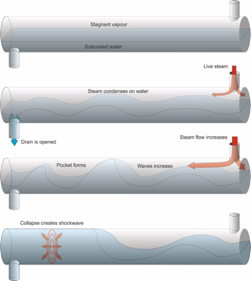Safety notice to act as a reminder of the phenomenon of condensate induced water hammer
Health and Safety Executive - Safety notice
Department Name:
EPD – Safety Unit – Edward Crick
Bulletin No:
STSU2 – 2019
Issue Date:
07.08.2019
Target Audience:
Operators of major pressure systems involving steam, including the following:
- Chemical processing and production
- Electricity generation
- Engineering
- Food Packaging and processing
- Gas
- Metals and Minerals processing and production
- Manufacturing (general)
- Nuclear
- Offshore
Key Issues:
Intent of notice is to remind operators of the risks of steam condensate water hammer following an incident.
Introduction
Following an incident currently being investigated by the Office for Nuclear Regulation, HSE is issuing this safety notice to remind duty-holders about condensate induced water hammer, and their responsibilities in terms of the maintenance and operation of steam systems. This notice is concerned with existing installations and assumes that the steam system has been appropriately designed.
Background
Three people were injured following a release of steam from a non-nuclear heating system. ONR investigations are ongoing, but early indications suggest a failure in the pressure boundary of the steam system, potentially caused by a water hammer event.
Water hammer is a known vulnerability in steam systems, and this is sometimes referred to as 'Condensate Induced Water Hammer'. Further information about how this occurs is displayed in the figure below.
It most commonly occurs when steam is introduced into cold pipe-work that has not been sufficiently drained. As the steam cools, it turns into condensate which takes up less volume in the pipework than the steam. This produces a vacuum or pocket into which the water rapidly flows, creating an impact against the pipework.
Although this figure shows water hammer occurring when steam flow increases, we are aware that condensate induced water hammer also occurs with a relatively steady flow of steam.

ONR may issue further information following completion of the investigation.
Action required
Dutyholders should remind themselves about this phenomenon in steam systems and ensure suitable measures are taken to prevent the occurrence of such events, including the appropriate operation and maintenance of such systems on their sites.
HSE recommend that the 5 point action plan detailed in the Safety Assessment Federation (SAFed) factsheet; "potential hazards created by water hammer in steam systems" is considered.
This includes taking into account the following:
- Enhanced training of boiler operators;
- Slope of pipework and drainage;
- Positions where condensate could collect;
- Operation of traps;
- Isolation valves.
SAFed's full fact sheet can be viewed on their website.
Relevant Legal Documents
Pressure Systems Safety Regulations 2000 (PSSR)
By law, Duty holders have a number of responsibilities under the Pressure Systems Safety Regulations (PSSR) 2000, including the following related to Operation and Maintenance:
- Regulation 11 – Operation
- Regulation 12 – Maintenance
Effective maintenance is essential to prevent condensate induced water hammer. The maintenance routine should include any steam traps in order to avoid condensate build up, and thus reduce the likelihood of condensate induced water hammer occurring.
References
- Fact sheet – Potential hazards created by water hammer in steam systems, Issue 1, May 1997.
- The Pressure Systems Safety Regulations 2000
- Safety of pressure systems - Pressure Systems Safety Regulations 2000, Approved Code of Practice and guidance, Second Edition, 2014.